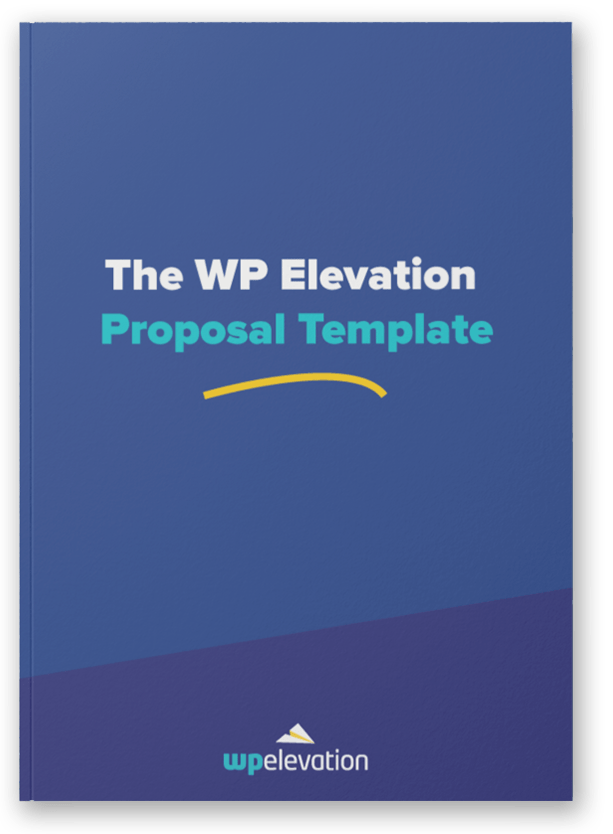One of the biggest mistakes you can make as a website consultant is creating a sales proposal from scratch every single time. For starters, there are the costs involved, and the process of writing a sales proposal itself can be out of your scope of expertise. But how can you get more business without a sales proposal?
The proposed solution: Sales proposal templates. Having a sales proposal template in place is a necessity to create proposals that contain all the relevant information in bullet points, and they offer numerous key benefits for both your company and your new clients.
Think about where you spend your money and ask yourself why. It's because you trust that you're going to get value for that money. And that trust comes from a feeling that the person you're paying understands the deal, the project, and its details, and knows both your company's background and what they're doing.
That feeling of trust comes from processes, procedures, and systems that are in place to deliver that value to you. And probably the most important process that you can incorporate into your business is a tried, tested, and highly converting sales proposal template.
I'm just going to say it – the reason you're losing projects to your competitors probably isn't because their work is better than yours. They just know how to articulate what they do to their prospective customers better than you do.
But don't worry, you're in the right place. I'm going to share a proposal template with you that will take your business to the next level. No matter what digital service you offer, you can take this sales proposal template and tweak it to entice prospective clients, get more business, save yourself a lot of time, and come in on – or under – budget!

The Proposal Template
Before I started Agency Mavericks, I spent 8 years as a WordPress consultant working with clients such as Quickbooks and F1 Grand Prix.
When I started out, I was sending sales proposals as a Word Doc or in Google Docs and I thought perhaps it was the design and design details that were letting me down. So I tried getting them professionally designed. But really, I had absolutely no idea what was working and what wasn't. I didn't even know if the proposal was being opened or if customers were interested in my services, much less if they contained all the information needed to close deals.
Then I discovered some software called SlideRocket. This service allowed me to send the sales proposal as a slide deck that incorporated all the key messages for potential customers. From there, I could track when it was being opened and how much time was being spent on each slide. I used this valuable data and asked for feedback from potential clients and eventually discovered the winning formula for sales proposals.
Oh, and it turns out that just a standard Word Doc saved as a pdf converts way better than a professionally designed sales proposal.
So now I share this sales proposal template openly and it is currently being used by thousands of WordPress consultants all over the world to generate in excess of $50M a year in consulting revenue.
Right now you probably just want to download it and get started. But it's a good idea to read on so that you can understand the purpose behind each section and why it converts so well.

Download Your Free Proposal Template
The Proposal Template Breakdown
Snapshot
This is a simple and short paragraph that opens your proposals. The snapshot states who you are, who the client is, and the fact that they've approached you to make a website.
Business Needs
In this section, you reiterate to the client what they've told you in the discovery session. Outline why they need the website and what their goals are. Try to use the exact same wording that the client used so that they know you completely understand them and their needs.
Target Audience Needs
Here you say who the target audience is and what they need from the website.
Solution
In this section, you propose how it is that their new website will help them achieve their goals and the audience achieve their needs.
This is where you outline the benefits rather than features. Don't talk about anything technical here such as “plugins” or “opt-in forms”. Only talk about the benefits that those features will provide for the client.
This is really a key part of the professional sales proposal. The client doesn't understand why they're being asked to spend all this money. The technical jargon doesn't mean anything to them. But if you can show them the benefits that they will receive, using the most relevant information, then you are speaking their language. This is where you will be articulating what you do much better than your competitors.
Here are some examples:
Feature: Opt-in box or sign up form
Benefit: Increase leads
Feature: Blog with categories and tags
Benefit: Drive more traffic to your site from search engines
Timeline
This is where you start setting the expectations by explaining how long the project should take and what the major milestones are within the project. For example:
Discovery - 4 Weeks
Development of a sitemap and interactive prototype so that all functionality can be tested and approved in the browser.
Design - 3 Weeks
Design of website user experience and user interface to allow the target audience to easily navigate and use the website to achieve their needs.
Development - 4 Weeks
Development of working website on the WordPress content management system.
Deployment - 1 Week
Final testing and debugging on development server before launching.
Investment
This is what you're asking your client to invest so that they can reach their goals. It is important not to call it “pricing” or “cost” as the website will be making them money, not costing them money.
FAQ's
This section was a game-changer for me. Straight after the client reads the investment, you can then answer all of their objections. If you've dealt with some clients you will probably know what the most common objections are. I've added what I believe to be the most common objections in the sales proposal template.
Next Steps
Once I added this section I found it amazing how by telling clients what to do, they're much more inclined to just do it. This way, the prospect of what you can achieve for them begins to feel real and takes them from the present day to what your project can create for their future.
Here you can tell them how to sign the agreement document and return it to you. I like to use Bidsketch when it comes to bid proposal, but there are some other great tools that you can use for this. Otherwise, you can simply tell them to sign it and return it to you.
Mutual Agreement
I don't like to call this section “terms and conditions”, I prefer to call it a mutual agreement. Here, I outline the final proposal and what we will do for the client in writing, lay all the details on the table, and clarify what the client's responsibilities are as well.
OK, now it's time to download the sales proposal template and start winning more clients!

